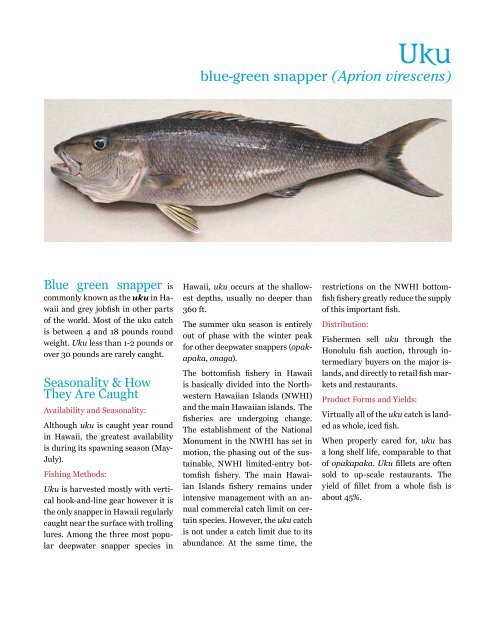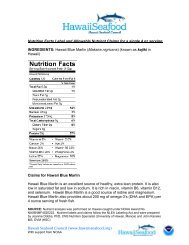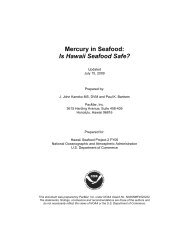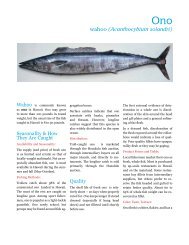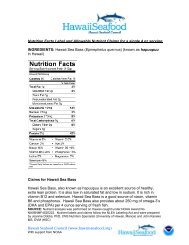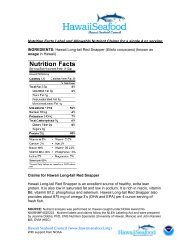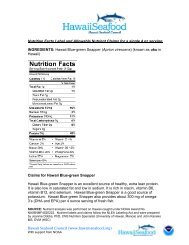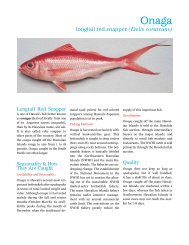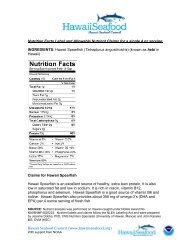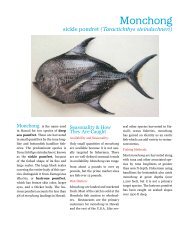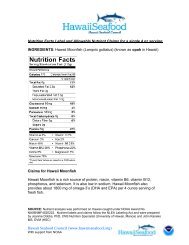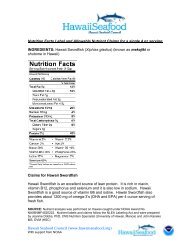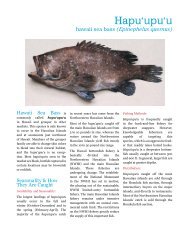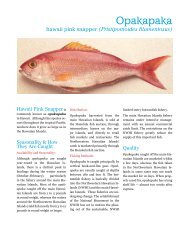blue-green snapper (Aprion virescens) - Hawaii Seafood
blue-green snapper (Aprion virescens) - Hawaii Seafood
blue-green snapper (Aprion virescens) - Hawaii Seafood
You also want an ePaper? Increase the reach of your titles
YUMPU automatically turns print PDFs into web optimized ePapers that Google loves.
Uku<br />
<strong>blue</strong>-<strong>green</strong> <strong>snapper</strong> (<strong>Aprion</strong> <strong>virescens</strong>)<br />
Blue <strong>green</strong> <strong>snapper</strong> is<br />
commonly known as the uku in <strong>Hawaii</strong><br />
and grey jobfish in other parts<br />
of the world. Most of the uku catch<br />
is between 4 and 18 pounds round<br />
weight. Uku less than 1-2 pounds or<br />
over 30 pounds are rarely caught.<br />
Seasonality & How<br />
They Are Caught<br />
Availability and Seasonality:<br />
Although uku is caught year round<br />
in <strong>Hawaii</strong>, the greatest availability<br />
is during its spawning season (May-<br />
July).<br />
Fishing Methods:<br />
Uku is harvested mostly with vertical<br />
hook-and-line gear however it is<br />
the only <strong>snapper</strong> in <strong>Hawaii</strong> regularly<br />
caught near the surface with trolling<br />
lures. Among the three most popular<br />
deepwater <strong>snapper</strong> species in<br />
<strong>Hawaii</strong>, uku occurs at the shallowest<br />
depths, usually no deeper than<br />
360 ft.<br />
The summer uku season is entirely<br />
out of phase with the winter peak<br />
for other deepwater <strong>snapper</strong>s (opakapaka,<br />
onaga).<br />
The bottomfish fishery in <strong>Hawaii</strong><br />
is basically divided into the Northwestern<br />
<strong>Hawaii</strong>an Islands (NWHI)<br />
and the main <strong>Hawaii</strong>an islands. The<br />
fisheries are undergoing change.<br />
The establishment of the National<br />
Monument in the NWHI has set in<br />
motion, the phasing out of the sustainable,<br />
NWHI limited-entry bottomfish<br />
fishery. The main <strong>Hawaii</strong>an<br />
Islands fishery remains under<br />
intensive management with an annual<br />
commercial catch limit on certain<br />
species. However, the uku catch<br />
is not under a catch limit due to its<br />
abundance. At the same time, the<br />
restrictions on the NWHI bottomfish<br />
fishery greatly reduce the supply<br />
of this important fish.<br />
Distribution:<br />
Fishermen sell uku through the<br />
Honolulu fish auction, through intermediary<br />
buyers on the major islands,<br />
and directly to retail fish markets<br />
and restaurants.<br />
Product Forms and Yields:<br />
Virtually all of the uku catch is landed<br />
as whole, iced fish.<br />
When properly cared for, uku has<br />
a long shelf life, comparable to that<br />
of opakapaka. Uku fillets are often<br />
sold to up-scale restaurants. The<br />
yield of fillet from a whole fish is<br />
about 45%.
Quality<br />
Color, Taste, Texture:<br />
Like other <strong>snapper</strong>s from <strong>Hawaii</strong>,<br />
uku<br />
uku is<br />
Preparations<br />
Uku is excellent prepared bake,<br />
broiled, sautéed, steamed and raw.<br />
Uku harvested during the summer<br />
season is often rich in natural fat, a<br />
desirable attribute for sashimi.<br />
very delicate opakapaka. While<br />
sashimi from opakapaka and onaga<br />
are more common, uku sashimi is<br />
thought to be one of the most under<br />
rated and underappreciated species<br />
<strong>Hawaii</strong> <strong>Seafood</strong> Council<br />
Acknowledgement: produced with support from NOAA<br />
www.hawaii-seafood.org


